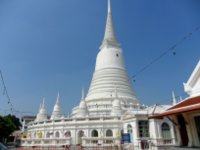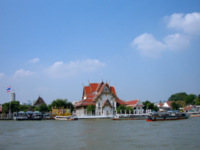- Home
- Bangkok Temples
- Wat Arun
Wat Arun
the Temple of Dawn
By Eric Lim
Wat Arun, the Temple of Dawn an old Ayutthaya period temple is one of the best known landmarks on the Chao Phraya River; with its towering prang glittering in the sun making it a favourite for the Bangkok temple tours.
The temple has been marked on old French maps since the 17th century. An old French photograph in the mid-19th century depicts the temple with its famous tall prang by the Chao Phraya.
This scene remains unchanged to this day.
Brief history of Wat Arun
The temple was originally called Wat Makok (makok – wild plum tree) and it was near an old village called Ban Kok (village of wild plums). After the fall of Ayutthaya in 1767, King Taksin decided to establish his capital in this area Thonburi on the west bank of the Chao Phraya.
He arrived in the area in time to catch the majestic sight of the prang in the light of dawn and vowed to restore the temple.
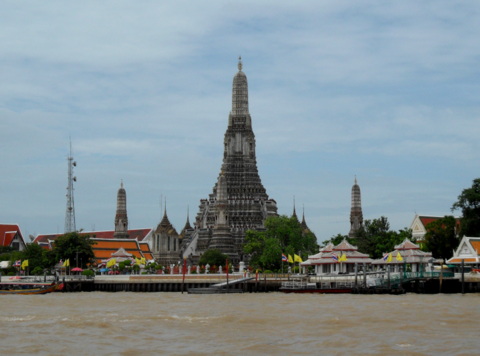
The Temple of Dawn in 2012
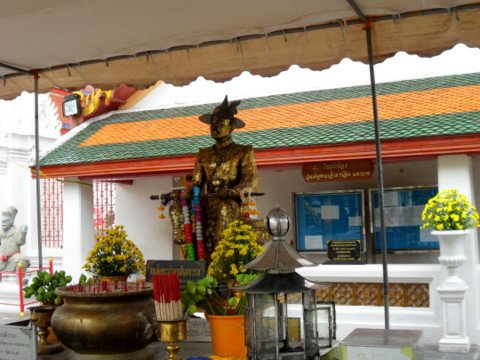
King Taksin Shrine in front of the entrance to the prang
After the temple was restored, King Taksin changed the name to Wat Jaeng (jaeng – dawn), the temple of dawn. He decided to build his palace nearby. Later when the Siamese army captured Vientiane, they took the Emerald Buddha and installed it in Wat Jaeng.
In the reign of King Rama I, the Emerald Buddha was moved to the Temple of the Emerald Buddha.
The temple underwent further restoration in 1785 by King Rama II when he was Crown Prince. The name of the temple was changed to Wat Arun Ratchatharam (arun – dawn).
King Rama IV gave the temple its present name Wat Arun Ratchawararam Ratchaworamahawiharn, to denote its status as a first class royal temple of the first grade, the highest.
Please see map to the Temple of Dawn
Guided temple tour of Wat Arun
Let's take a virtual guided tour of this Bangkok temple. Most visitors would head straight for the tall prang which tends to overshadow the rest of the temple. But the other buildings in the temple complex with their beautiful structures, interior decor and peaceful atmosphere have their merits.
The suggested order of touring Wat Arun is listed below.
- Ubosot – ordination hall
- Viharn – prayer hall
- Mondop – with Buddha’s footprint
- Prang
- Monument to King Rama II
Please see satellite map for the layout of the temple.
View Wat Arun - temple layout in a larger map
Obosot – ordination or ceremony hall
As soon as you get off the ferry and enter Wat Arun, you will encounter this pair of yak, giant demons guarding the gate to the ubosot. These demons are the villains in the Ramakien drama, the Thai version of the Hindu Ramayana epic.
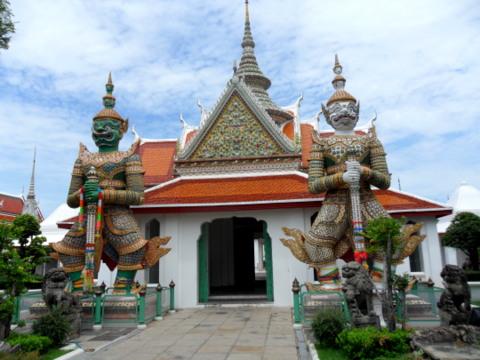
Demons at the gate – Sahassadecha (right) and Thossakun (left)
Go through this gate and enter a room leading to another door with murals painted on them.
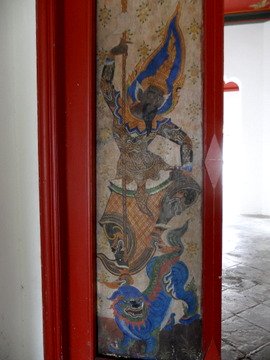
The passage to the ubosot
This door leads to a quiet courtyard. You will immediately be struck by the serenity in here. All the noise from the river seems to be completely shut off.
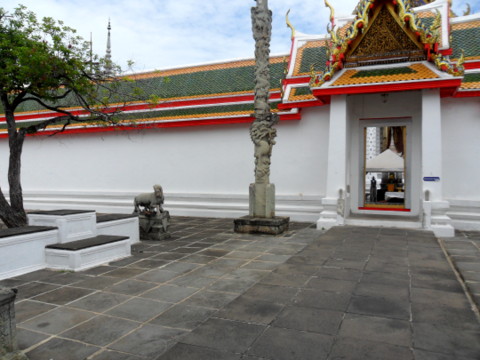
The quiet courtyard, the ubosot is the inner courtyard through the door
The ubosot or ordination hall is in an inner courtyard. It has a two-tiered roof with chofars, door frames and colourful porcelain walls lined with gilded borders.
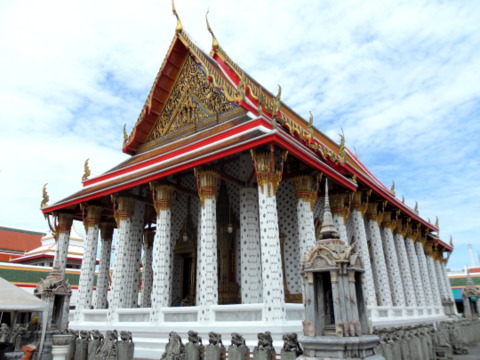
Ubosot or ordination hall
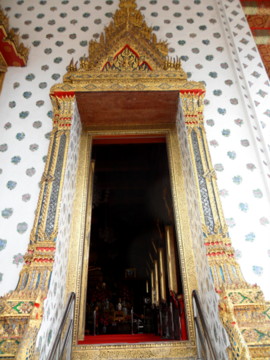
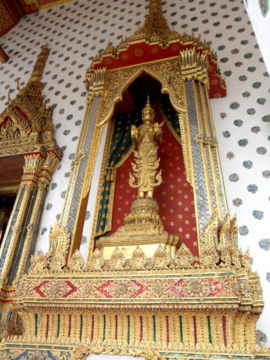
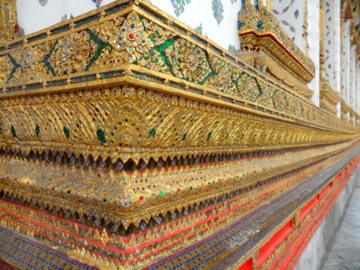
A covered passageway, phra rabiengkote, lines the walls around the ubosot. The passage is lined with 120 Buddha statues in the sitting position.
These statues were cast in the reign of King Rama II. The remains of deceased are kept in cubicles below the statues.
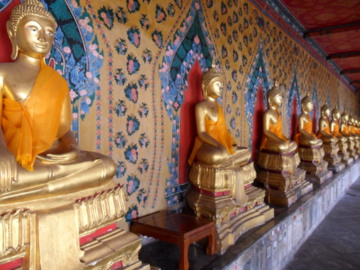
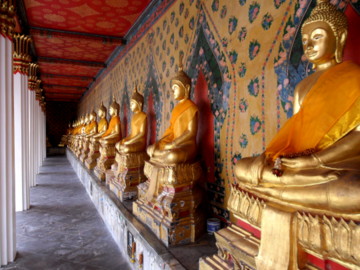
The interior of the ubosot is really beautiful. Colourful murals line the walls from the floor to the ceiling. A lady was seated in one of chairs at the back wall, in deep contemplation. This is just the place for it.
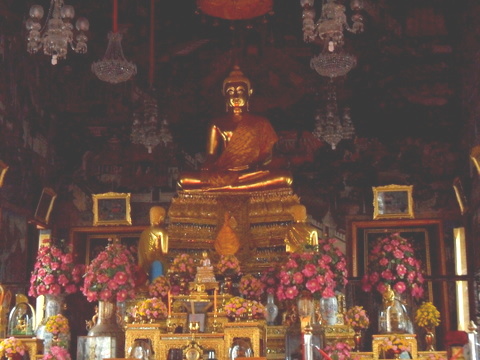
Buddha image in the ubosot, note the murals behind
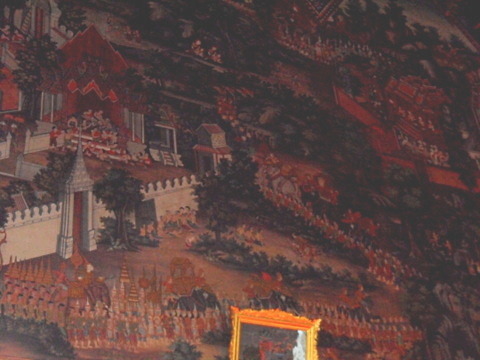
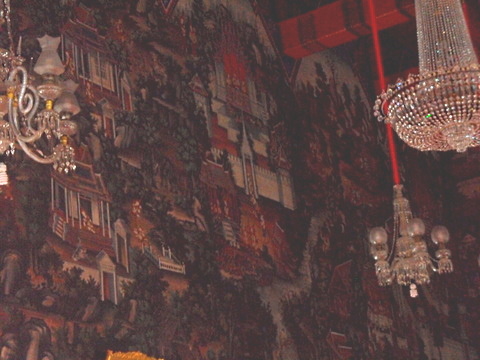
Back to contents
Viharn – prayer hall
The viharn or sermon hall next to the ubosot is also in a very peaceful part of Wat Arun. Few visitors venture here, there was an army officer was praying at the altar. This is another part of the temple where you can really get some peace and quiet.
The viharn is an equally impressive building, both the exterior and interior.
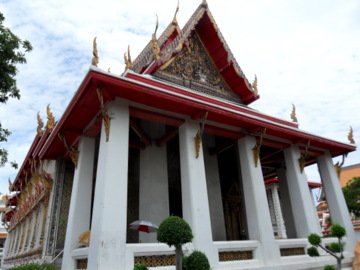
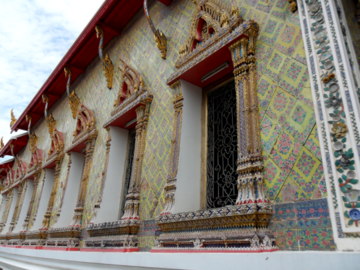
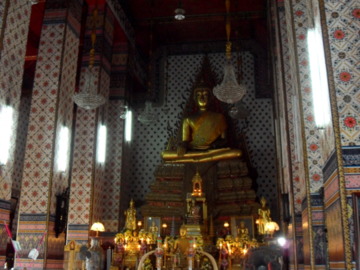
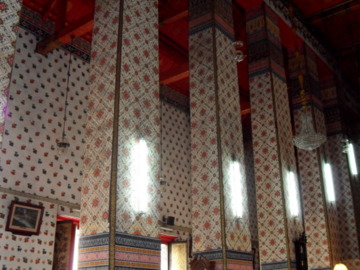
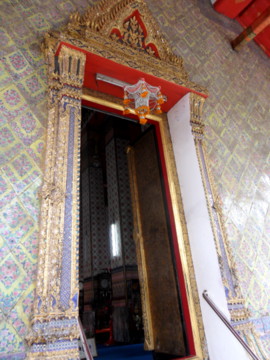
Back to contents
Mondop with Buddha’s footprint
The mondop, a square structure with a pyramidal roof, is located just next to the viharn.
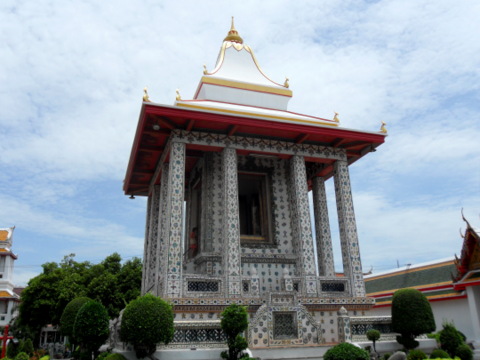
Mondop with Buddha’s footprint
A flight of steps leads up to the chamber where a copy of Buddha’s footprint is carved in stone and decorated with porcelain.
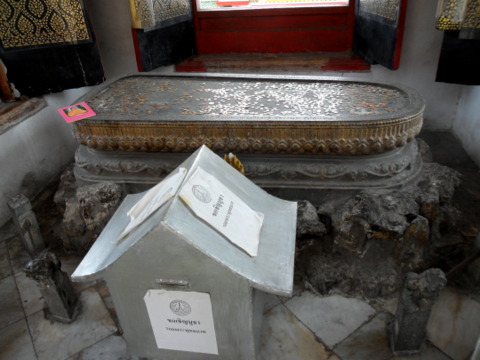
Buddha’s footprint carved in stone
The mondop and viharn are near the kuti or monks’ quarters away from the river and the tourists. There’s a beautiful garden in front of the mondop donated by a temple well-wisher and his family.
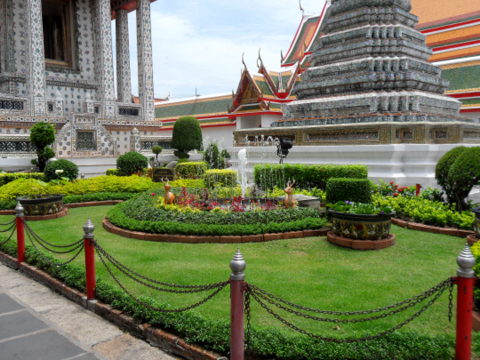
Garden in front of the mondop
Back to contents
Prang
I have kept the best till last; it's also the hardest part. The prang is an 81 m high Khmer spire with elaborate carvings. Four smaller prang are placed at the four corners of the main prang.
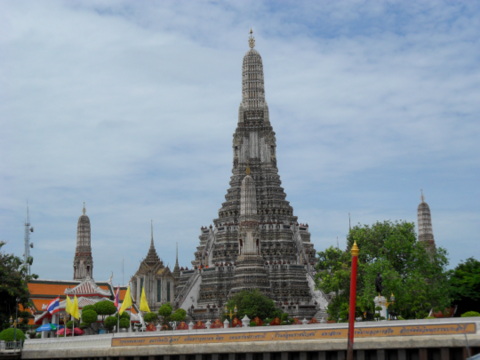
The famous prang
Hundreds of pieces of porcelain are embedded on the sides giving that glitter in the sun.
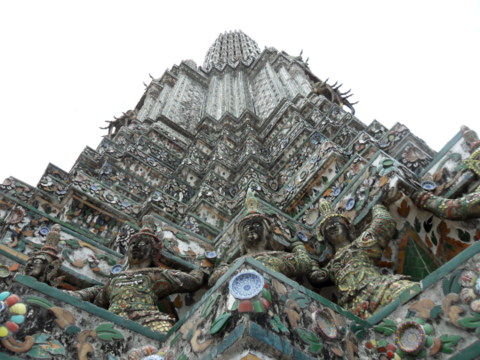
The porcelain studded prang
There are four levels to the prang; the first two are relatively easy to climb. The third and fourth levels are reached by steep steps that are almost at a 60 % gradient!
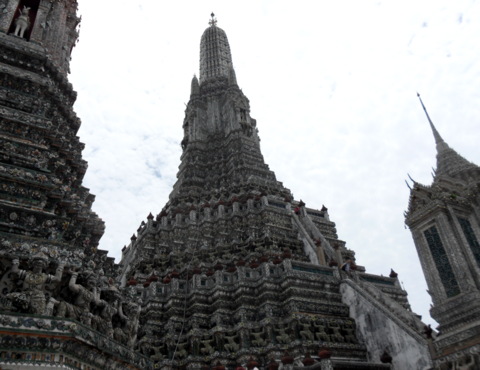
The steep steps up
You will have to pull yourself up with help of the railings. Just imagine you are pulling yourself up a steep slope with the help of a rope. It is definitely worth the effort. The view is beautiful.
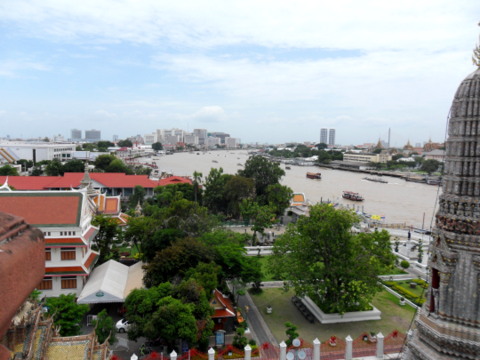
View of the Chao Phraya
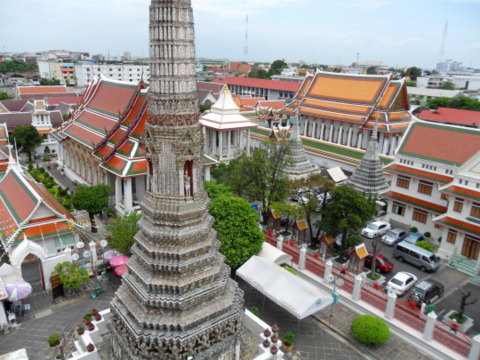
View of the temple complex
When you are descending don't try to walk down like you are walking down a flight of steps. Go down in reverse and hold the railings to control your descend, like you are going down a steep slope on a rope.
The foundations under the prang are something that is worth a thought.
Old French maps printed in the reign of King Narai (1656 – 1688) show the existence of Wat Arun. This makes the temple at least 500 hundred years old.
Considering the soft silt on the banks of the Chao Phraya, what was used as the foundation to support such a massive structure?
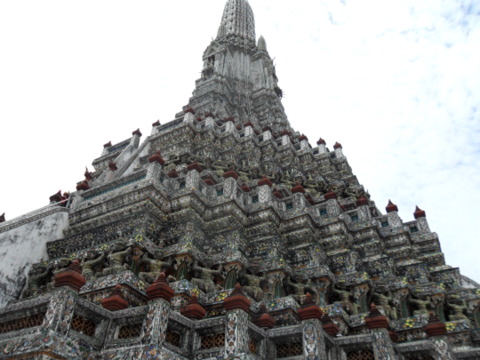
Historical records indicate that huge beams were piled into the soft river banks. As they didn't have reinforced concrete then, these piles must have been timber, hard, durable timber. Several layers must have been used for the prang.
Old buildings on the Chao Phraya like Assumption Cathedral and the First Presbyterian Church were built on similar foundations.
Back to contents
Monument of King Rama II
Near the banks of the Chao Phraya stands a statue of King Rama II. In 1785 when he was the Crown Prince, King Rama II restored Wat Arun. King Rama II (1809 – 1824) was known for his contribution to literature.
In 1967, the United Nations honoured him as a World Cultural Leader. This monument was erected on 2 November 1996.
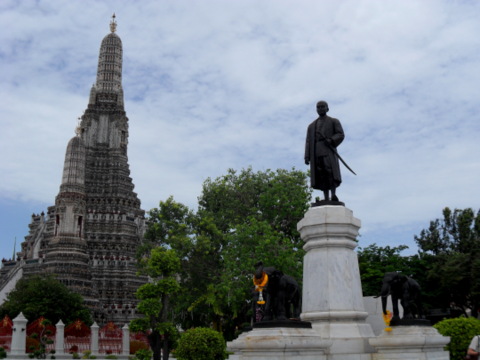
Monument to King Rama II
Back to contents
Could the people who built Wat Arun centuries ago have imagined that one day the Temple of Dawn would be such a famous landmark in Bangkok and an enduring icon on the Chao Phraya?
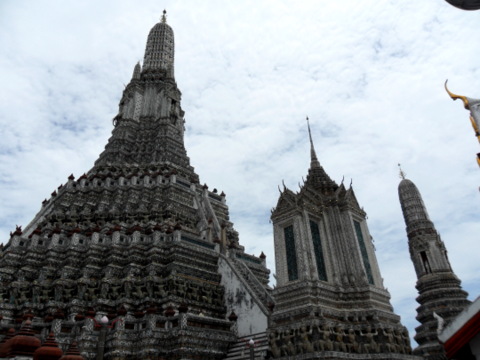
An enduring icon
Map to Wat Arun
View Wat Arun - how to get there in a larger map
How to get there
Take a Chao Phraya river boat from the Sathorn Pier that is below S6 Saphan Taksin Station.
Alight at N8 Tian Pier, the pier near Wat Pho.
Fare is 15 baht for the orange flag boat and 40 baht for the tourist boat.
From Wat Pho take a ferry across to Wat Arun. The ferry pier is just next to the river boat pier. Fare is 3 baht each way.
To return to Bangkok Temples.
Other temples nearby
My Journey through Thailand Part I The First StepsThis is my second e-book and the first in the series of travel journals on my trips to explore the various provinces in Thailand. This edition, which covers my travels from late 2009 to mid-2013, will guide you to historical sites, cultural monuments and exquisite Thai handicraft, across a vast spectrum of cultural and ethnic diversity.
You can have a virtual tour with this e-guide book or take the first steps yourself in this journey through Thailand.
My Kindle edition

Search Tour Bangkok Legacies with DuckDuckGo
Other temples nearby
My Journey through Thailand
Part I The First Steps
My Kindle edition

My Smashwords edition

